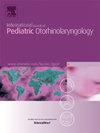Associations of prenatal exposure to lead and mercury with auditory function in infants
IF 1.2
4区 医学
Q3 OTORHINOLARYNGOLOGY
International journal of pediatric otorhinolaryngology
Pub Date : 2025-05-15
DOI:10.1016/j.ijporl.2025.112393
引用次数: 0
Abstract
Purpose
This study examined the association between lead (Pb) and mercury (Hg) exposure during early brain development with auditory function in infants.
Methods
Auditory function of six-month-old infants from the Maternal-Infant Research on Environmental Chemicals-Infant Development (MIREC-ID) cohort was assessed with minimal auditory response levels (MRLs) to warble tones and speech in soundfield, tympanometry, and otoacoustic emissions (OAEs; transient – TEOAEs; and distortion product – DPOAEs). Pb and total Hg concentrations in blood samples were obtained at three time points: maternal blood samples at the first and third trimesters of pregnancy, and umbilical cord blood samples at birth.
Results
Higher maternal blood Pb concentrations during pregnancy were significantly related with low OAEs. The associations were stronger for TEOAEs, in particular TEOAE reproducibility, than DPOAEs, and were stronger in the left ear compared with the right ear for TEOAEs. Pb was barely associated with MRLs. No clear evidence of association between Hg exposure and auditory function (OAEs and MRL) was found.
Conclusions
Developmental exposure to low Pb concentrations are associated with a reduction of outer hair cells responses to sounds, suggestive of a decrease in inner ear function. Further studies are needed to verify these results in a larger sample of infants.
产前接触铅和汞与婴儿听觉功能的关系
目的研究婴幼儿早期脑发育过程中铅、汞暴露与听觉功能的关系。方法:对来自环境化学物质母婴研究-婴儿发育(MIREC-ID)队列的6个月大婴儿的听觉功能进行评估,采用声场、鼓室测量和耳声发射(oae)对颤音和语音的最小听觉反应水平(MRLs);瞬态teoae;和失真产品- dpoae)。在三个时间点获得血液样本中的铅和总汞浓度:妊娠早期和晚期的母亲血液样本,以及出生时的脐带血样本。结果妊娠期孕妇血铅浓度增高与低oae显著相关。与dpoae相比,TEOAE的相关性更强,尤其是TEOAE的可重复性,TEOAE在左耳的相关性比右耳强。铅与核磁共振成像几乎没有相关性。没有明确的证据表明汞暴露与听觉功能(oae和MRL)之间存在关联。结论发育期低铅暴露与外毛细胞对声音的反应减少有关,提示内耳功能下降。需要进一步的研究在更大的婴儿样本中验证这些结果。
本文章由计算机程序翻译,如有差异,请以英文原文为准。
求助全文
约1分钟内获得全文
求助全文
来源期刊
CiteScore
3.20
自引率
6.70%
发文量
276
审稿时长
62 days
期刊介绍:
The purpose of the International Journal of Pediatric Otorhinolaryngology is to concentrate and disseminate information concerning prevention, cure and care of otorhinolaryngological disorders in infants and children due to developmental, degenerative, infectious, neoplastic, traumatic, social, psychiatric and economic causes. The Journal provides a medium for clinical and basic contributions in all of the areas of pediatric otorhinolaryngology. This includes medical and surgical otology, bronchoesophagology, laryngology, rhinology, diseases of the head and neck, and disorders of communication, including voice, speech and language disorders.

 求助内容:
求助内容: 应助结果提醒方式:
应助结果提醒方式:


